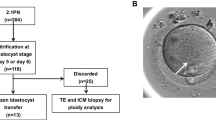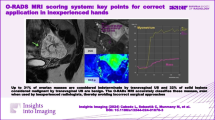Abstract
Purpose
To determine if Aneuploidy Risk Classification Models are predictive of euploidy/aneuploidy amongst IVF facilities.
Methods
We retrospectively applied key time lapse imaging events of embryos (Campbell et al.[5, 6]) to stratify embryos into 3 groups: low, medium and high risk of aneuploidy. The actual ploidy results (from array comparative genomic hybridization) were compared with expectations [5, 6]. Sources of variability in morphokinetic parameters were determined using Analysis of Variance (ANOVA).
Results
The model failed to segregate euploid embryos from aneuploid embryos cultured at our facility. Further analysis indicated that the variability of embryos among patients was too great to allow selection of euploid embryos based on simple morphokinetic thresholds. Clinical selection of embryos based on morphokinetics alone is unlikely to identify euploid embryos accurately for transfer or yield higher rates of live delivery.
Conclusions
The use of non-invasive morphokinetics is unlikely to discriminate aneuploid from euploid embryos. Further, it does not approach the accuracy of preimplantation genetic screening with array comparative genomic hybridization.


Similar content being viewed by others
References
Grifo J, Hodes-Wertz B, Hsiao-Ling L, Amperloquio E, Clarke-Williams M, Adler A. Single thawed euploid embryo transfer improves IVF pregnancy, miscarriage and multiple gesation outcomes and has similar implantation rates as egg donation. Journal of Assisted Reproduction and Genetics. 2013. doi:10.1007/s10815-012-9929-1.
Harton G, Munne S, Surrey M, Grifo J, Kaplan B, McCulloh D, Griffin D, Wells D. Dimished effect of maternal age on implantation after preimplantation genetic diagnosis with array comparative genomic hybridization.
Conaghan J, Chen AA, Willman SP, Ivani K, Chenette PE, Boostanfar R, et al. Improving embryo selection using a computer-automated time-lapse image analysis test plus day 3 morphology: results from a prospective multicenter trial. Fertility and Sterility. 2013;100(2):412–9.e5.
Chamayou S, Patrizio P, Storaci G, Tomaselli V, Alecci C, Ragolia C, et al. The use of morphokinetic parameters to select all embryos with full capacity to implant. Journal of Assisted Reproduction and Genetics. 2013;30:703–10.
Campbell A, Fishel S, Bowman N, Duffy S, Sedler M, Hickman C. Modelling a risk classification of aneuploidy in human embryos using non-invasive morphokinetics. Reproductive biomedicine online. 2013;26:477–85.
Campbell A, Fishel S, Bowman N, Duffy S, Sedler M, Thornton S. Retrospective analysis of outcomes after IVF using an aneuploidy risk model derived from time-lapse imaging without PGS. Reproductive Biomedicine Online. 2013;27:140–6.
Rubio C, Buendía P, Rodrigo L, Mercader A, Mateu E, Peinado V, et al. Prognostic Factors for preimplantantion genetic screening in repeated pregnancy loss. Reproductive Biomedicine Online. 2009;18(5):687–93.
Huang CC, Chang LJ, Tsai YY, Hung CC, Fang MY, Su YN, Chen HF, Chen SU. A feasible strategy of preimplantation genetic diagnosis for carriers with chromosomal translocation: Using blastocyst biopsy and array comparative genomic hybridization.
Gardner DK, Lane M. Culture and selection of viable blastocysts: a feasible proposition for human IVF? In: Human reproduction update. 3rd ed. 1997. p. 367–82.
Gutierrez-Mateo C, Colls P, Sanchez-Garcia J, Escudero T, Prates R, Ketterson K, et al. Validation of microarray comparative genomic hybridization for comprehensive chromosome analysis of embryos. Fertility and sterility. 2011;95:953–8.
Hodes-Wertz B, Grifo J, Ghadir S, Kaplan B, Laskin CA, Glassner M, et al. Idiopathic recurrent miscarriage is caused mostly by aneuploid embryos. Fertility and Sterility. 2012;98(3):675–80.
Wong C, Loewke KE, Bossert NL, Behr B, De Jonge CJ, Baer TM, et al. Non-invasive imaging of human embryos before embryonic genome activation predicts development to the blastocyst stage. Nature biotechnology. 2010;28:1115–21.
Kirkegaard K, Agerholm IE, Ingerslev HJ. Time-lapse monitoring as a tool for clinical embryo assessment. Human reproduction. 2012;27:1277–85.
Meseguer M, Rubio I, Cruz M, Basile N, Marcos J, Requena A. Embryo incubation and selection in a time-lapse monitoring system improves pregnancy outcome compared with a standard incubator: a retrospective cohort study. Fertility and sterility. 2012;98(6):1481–9.
Kirkegaard K, Hindkjaer J, Ingerslev HJ. Human embryonic development after blastomere removal: a time-lapse analysis. Human reproduction. 2012;27:97–105.
Gardner DK, Schoolcraft WB. Human embryo viability: what determines developmental potential, and can it be assessed? Journal of Assisted Reproduction and Genetics. 1998;15(8):455–58.
Paternot G, Devroe J, Debrock S, D'Hooghe TM, Spiessens C. Intra- and inter- observer analysis in the morphological assessment of early stage embryos. Reproductive Biology and Endocrinology. 2009;7:105.
Herrero J, Meseguer M. Selection of high potential embryos using time-lapse imaging: the era of morphokinetics. Fertility and Sterility. 2013;99(4):1030–34.
Braude P, Bolton V, Moore S. Human gene expression first occurs between the four- and eight-cell stages of preimplantation development. Nature. 1988;332:459–61.
Levy R. Genetic regulation of preimplantation embryo survival. International Review of Cytology. 2001;210:1–37.
Warner CM, Newmark JA, Comiskey M, De Fazio SR, O'Malley DM, Rajadhyaksha M, et al. Genetics and imaging to assess oocyte and preimplantation embryo health. Reproduction Fertility and Development. 2004;16(7):729–41.
Cao W, Brenner CA, Alikani M, Cohen J, Warner CM. Search for a human homologue of the mouse Ped gene. Molecular Human Reproduction. 1999;5(6):541–47.
Colls P, Escudero T, Fischer J, Cekleniak NA, Ben-Ozer S, Meyer B, et al. Validation of array comparative genome hybridization for diagnosis of translocations in preimplantation human embryos. Reproductive BioMedicine Online. 2012;24(6):621–9.
Forman EJ, Hong KH, Ferry KM, Tao X, Taylor D, Levy B, et al. In vitro fertilization with single euploid blastocyst transfer: a randomized controlled trial. Fertility and Sterility. 2013;100(1):100–7.
Author information
Authors and Affiliations
Corresponding author
Additional information
Capsule Morphokinetic parameters are insufficient to universally distinguish euploid from aneuploid embryos, predominantly due to the high degree of patient-to-patient variability and small intrapatient variability for parameters previously associated with blastocyst development or embryo ploidy.
Rights and permissions
About this article
Cite this article
Kramer, Y.G., Kofinas, J.D., Melzer, K. et al. Assessing morphokinetic parameters via time lapse microscopy (TLM) to predict euploidy: are aneuploidy risk classification models universal?. J Assist Reprod Genet 31, 1231–1242 (2014). https://doi.org/10.1007/s10815-014-0285-1
Received:
Accepted:
Published:
Issue Date:
DOI: https://doi.org/10.1007/s10815-014-0285-1




